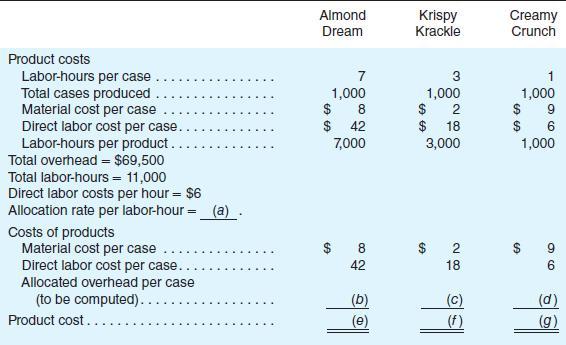Refer to Integrative Case 9-65 in Chapter 9. Assume that all of the facts in Case 9-65
Question:
Refer to Integrative Case 9-65 in Chapter 9. Assume that all of the facts in Case 9-65 still hold except that the practical capacity of the machinery is 20,000 hours instead of 10,000 hours.
Required
a. Recompute the unit costs for each of the cola products: Diet, Regular, Cherry, and Grape.
b. What is the cost of unused capacity? What do you recommend that Rockness Bottling do with this unused capacity?
c. Now assume that Rockness is considering producing a fifth product: Vanilla cola. Because Vanilla cola is in high demand in Rockness Bottling’s market, assume that it would use 10,000 hours of machine time to make 100,000 units. (Recall that the machine capacity in this case is 20,000 hours, while Diet, Regular, Cherry, and Grape consume only 10,000 hours.) Vanilla cola’s per unit costs would be identical to those of Diet cola except for the machine usage costs. What would be the cost of Vanilla cola? Calculate on a per-unit basis, and then in total.
Data From Case 9-65 in Chapter 9:
Chocolate Bars, Inc. (CBI), manufactures creamy deluxe chocolate candy bars. The firm has developed three distinct products: Almond Dream, Krispy Krackle, and Creamy Crunch.
CBI is profitable, but management is quite concerned about the profitability of each product and the product costing methods currently employed. In particular, management questions whether the overhead allocation base of direct labor-hours accurately reflects the costs incurred during the production process of each product.
In reviewing cost reports with the marketing manager, Steve Hoffman, who is the cost accountant, notices that Creamy Crunch appears exceptionally profitable and that Almond Dream appears to be produced at a loss. This surprises both him and the manager, and after much discussion, they are convinced that the cost accounting system is at fault and that Almond Dream is performing very well at the current market price.
Steve decides to hire Jean Sharpe, a management consultant, to study the firm’s cost system over the next month and present her findings and recommendations to senior management. Her objective is to identify and demonstrate how the cost accounting system might be distorting the firm’s product costs.
Jean begins her study by gathering information and documenting the existing cost accounting system. It is rather simplistic, using a single overhead allocation base—direct labor-hours—to calculate and apply overhead rates to all products. The rate is calculated by summing variable and fixed overhead costs and then dividing the result by the number of direct labor-hours. The product cost is determined by multiplying the number of direct laborhours required to manufacture the product by the overhead rate and adding this amount to the direct labor and direct material costs.
CBI engages in two distinct production processes for each product. Process 1 is labor intensive, using a high proportion of direct materials and labor. Process 2 uses special packing equipment that wraps each individual candy bar and then packs it into a box of 24 bars. The boxes are then packaged into cases, each of which has six boxes. Special packing equipment is used on all three products and has a monthly capacity of 3,000 cases, each containing 144 candy bars (= 6 boxes × 24 bars).
To illustrate the source of the distortions to senior management, Jean collects the cost data for the three products, Almond Dream, Krispy Krackle, and Creamy Crunch (see Exhibit 9.21).
Exhibit 9.21:

CBI recently adopted a general policy to discontinue all products whose gross profit margin percentages [(Gross margin ÷ Selling price) × 100] were less than 10 percent. By comparing the selling prices to the firm’s costs and then calculating the gross margin percentages, Jean could determine which products, under the current cost system, should be dropped. The current selling prices of Almond Dream, Krispy Krackle, and Creamy Crunch are $85, $55, and $35 per case, respectively. Overhead will remain $69,500 per month under all alternatives.
Step by Step Answer:

Fundamentals of Cost Accounting
ISBN: 978-1259565403
5th edition
Authors: William Lanen, Shannon Anderson, Michael Maher





